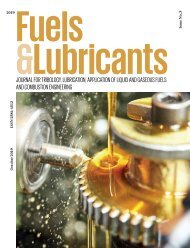Fuels & Lubricants Magazine
Issue No. 3, October 2018
Issue No. 3, October 2018
You also want an ePaper? Increase the reach of your titles
YUMPU automatically turns print PDFs into web optimized ePapers that Google loves.
TECHNOLOGY CORNER<br />
Application of Process Modeling<br />
and Simulation through the<br />
Life-Cycle of a Process<br />
Process Development Phases Seen through the Mathematical<br />
Modeling Aspects<br />
Ivana Lukec<br />
The process models are an<br />
explicit way of describing<br />
the knowledge of the process<br />
and related phenomena.<br />
They provide a systematic<br />
approach to the problems in<br />
all the stages of the process<br />
life-cycle.<br />
Most important stages of the<br />
life-cycle of a process are research<br />
and development, conceptual design,<br />
detailed engineering and operation.<br />
These different steps partially<br />
overlap and there is, as well, some<br />
feedback between them. Often, the<br />
same models, with some changes, are<br />
preferably utilized in all the steps.<br />
The good transfer of information,<br />
knowledge, and ideas are important<br />
for successful completion of all the<br />
process phases. Commercial modeling<br />
software packages are frequently<br />
used as an excellent platform.<br />
Process Modeling through the<br />
Research and Development<br />
Stage<br />
The models in the R&D stage can<br />
first be simple, and then become<br />
more detailed as work proceeds.<br />
At this stage, attention has to be<br />
focused on the phenomena of phase<br />
equilibrium, on the physical properties<br />
of the materials, on chemical kinetics<br />
as well as on the kinetics of<br />
mass and heat transfer.<br />
This action requires careful attention,<br />
especially because, at this<br />
life-cycle stage, the process could be<br />
nothing but an idea.<br />
The work starts with the physical<br />
properties, as they act as an input to<br />
all other components. The guidelines<br />
to choose physical properties, phase<br />
equilibrium data, characteristic state<br />
equations etc. can be found in the<br />
usual literature.<br />
36 <strong>Fuels</strong>&<strong>Lubricants</strong> No. 3 OCTOBER 2018







